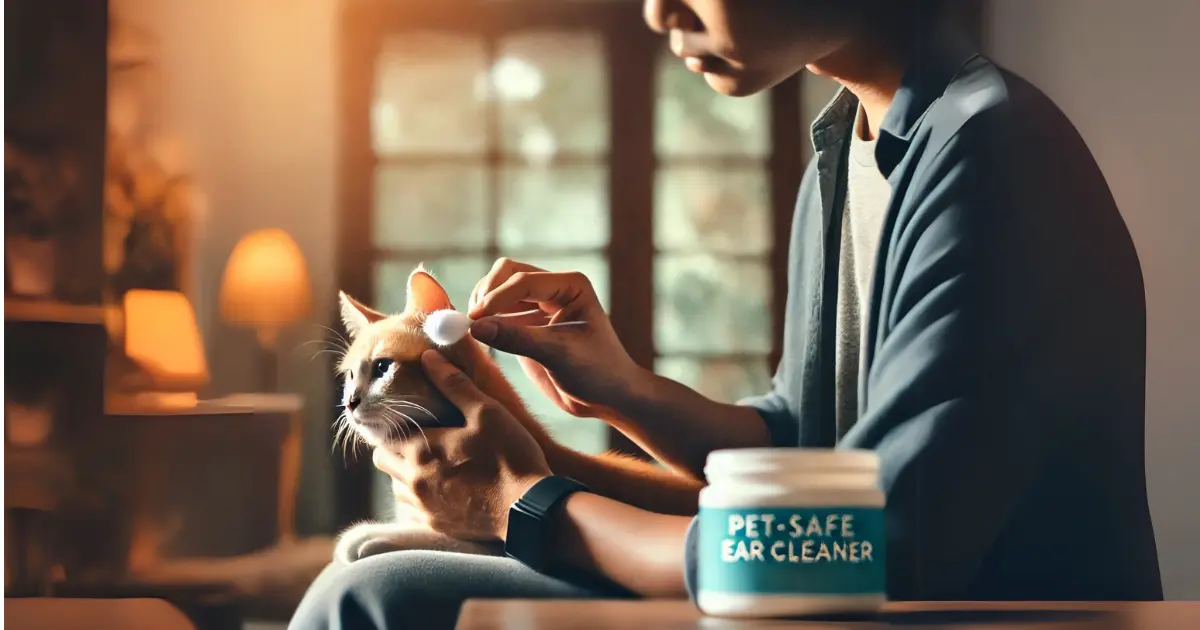Cat Ear Cleaning: A Simple Guide to Safely Clean Your Cat’s Ears
Published: 31 Jan 2025
If you’ve ever had to clean your cat’s ears, you know it can feel like a bit of an ordeal. Trust me, I get it! My own cat, Luna, has made a few protests during ear-cleaning sessions over the years. But things got much easier for us when I figured out how to do it. In this guide, I’ll share with you how I do cat ear cleaning safely—along with some tips and tricks I’ve learned through trial and error, so you can make it much less stressful for you and your cat.

Table of Contents
Why Should You Clean Your Cat’s Ears?
Before you dive in, let’s discuss why ear cleaning matters. Cats’ ears are sensitive, and cleaning them regularly keeps them healthy.
- Preventing Ear Infections: Ear infections are more common in cats than you might think, especially for those with floppy ears or long fur that can trap moisture. Regular ear cleaning helps keep things fresh and prevents the buildup of bacteria or yeast so your cat stays comfortable and healthy.
Regular ear cleaning helps keep things fresh and prevents the buildup of bacteria or yeast so your cat stays comfortable and healthy. Additionally, ensuring your cat has a well-balanced diet can help maintain their ear health, as some ear issues may be related to nutritional deficiencies. For more information, check out our guide to [Cat Nutrition].
- Avoiding Wax Buildup: Cats, like humans, can accumulate wax. Over time, this can affect their hearing or cause discomfort.
- Spotting Issues Early: Regular ear inspections help you spot issues early, whether dirt, wax, or a more serious infection.
I first realized how vital ear care was when Luna shook her head and scratched her ears. Although she might have been itchy, the problem was an ear infection that needed treatment. The issue might have been prevented if I’d been more proactive with cleaning.
Signs your cat might need ear cleaning:
- Scratching or rubbing their ears
- Shaking or tilting their head
- A weird, musty smell or unusual discharge from the ear

What You’ll Need to Clean Your Cat’s Ears
Before you start, gather everything you’ll need to make this task easier:
- Ear Cleaner: Always use a product specifically designed for cats. You can find some great, vet-approved options like [Brand Name] (I’ve had good luck with this one!).
- Cotton Balls or Pads: These are soft enough to clean your cat’s ears without damaging them. Avoid using cotton swabs, which can push debris deeper.
- Towel or Blanket: If your cat gets a little jittery (like Luna does), you can gently wrap it around a towel. This will help it stay calm and still.
- Treats: And, of course, don’t forget to give them a treat afterwards! It’s a simple way to let them know they did a good job and helps make the next ear cleaning more manageable.
Step-by-Step Instructions for Cleaning Your Cat’s Ears
Alright, let’s dive in! I promise I’ve made it super simple, with steps you can easily follow without confusion.
Step 1: Find a Calm, Quiet Spot
Make sure you’re in a safe, familiar spot with your pet. I like to do this on the sofa or floor, where Luna feels comfortable. Pick a place your pet is used to because this is one grooming session where patience helps them feel more at ease.
Step 2: Wrap Them Up (If Needed)
Luna used to give me the stink-eye whenever I’d get out the ear cleaner. If your cat’s not a fan of ear cleaning, gently wrap them in a towel to keep them calm and secure. I’ve found this helps when they’re trying to squirm away. It also keeps their claws from accidentally scratching you!
If your cat is more laid-back, let it sit on your lap or a stable surface while you clean.
Step 3: Take a Look Inside the Ears
Here, you need to do a quick inspection. If you notice any of the following, it might be time to clean:
- Redness or swelling: This can show an infection or irritation.
- Lousy smell: If your cat’s ears have a sour or yeasty smell, it’s a sign of bacteria or a fungal infection.
- Discharge: Brown, black, or even yellowish discharge is often a sign of ear mites or an infection.
- Excessive wax: Sometimes, you’ll see wax buildup, making your cat uncomfortable.
This is also a good time to check for cuts, bumps, or anything unusual. If you spot something concerning, call your vet before cleaning.
Step 4: Apply the Ear Cleaning Solution
Now, take the ear cleaner and gently squeeze a few drops into your cat’s ear canal (around 3-5 drops should do). Don’t stress—most cats handle this part pretty well! Give the base of their ear a gentle massage for about 20-30 seconds to help the solution loosen any wax or dirt. Luna is usually slightly annoyed by the massaging part, but she tolerates it because she knows it’s short and sweet.
Step 5: Wipe Clean
Once you’ve massaged the ear, take a soft cotton ball or pad and gently wipe away the dirt, wax, or fluid. Be careful not to push too deep into the ear—clean the outer parts of the ear canal.
I’ve learned the hard way not to use Q-tips! I pushed too far once, and Luna wasn’t too pleased. Now, I wipe the outer ear area, which works fine.
Step 6: Reward Your Cat (and Yourself!)
Once you’ve finished, give your cat a treat and lots of praise. I usually offer Luna a few belly rubs to show her I’m not the enemy. Positive reinforcement is key, and it helps them associate ear cleaning with something pleasant.

Why Each Step is Important
- Massaging the Ear: This step helps break up the wax and dirt, ensuring it doesn’t get stuck deep in the ear canal. It also spreads the solution around, making the cleaning more effective.
- Cotton Balls vs. Q-Tips: Cotton swabs can push debris further into the ear, leading to damage or infection. Cotton balls or pads are much gentler.
- Rewarding Your Cat: Trust me, your cat will appreciate it! Positive reinforcement makes the whole process smoother for both of you.
Just like regular ear cleaning, maintaining your cat’s dental hygiene is essential for their overall health. Be sure to check out our guide on how to [Clean Cat Teeth] effectively, which will help keep your cat’s teeth and ears in top shape
How Often Should You Clean Your Cat’s Ears?
Here’s the thing—overcleaning can irritate your cat’s ears. You don’t need to clean them weekly unless your cat is prone to ear problems. Here’s what I recommend:
- Weekly Checks: Check your cat’s ears weekly for signs of wax buildup, dirt, or discomfort.
- Clean When Needed: “If your cat’s ears look dirty or show signs of discomfort, it’s probably time for a cleaning.
- Avoid Over-Cleaning: You—only clean their ears when it’s needed. Too much cleaning can dry out the ear canal and make things worse.”
When to Call the Vet
Sometimes, ear issues go beyond simple cleaning. Here are a few signs that it might be time for a vet visit:
- Ear Infections: If you notice redness, swelling, or a foul odour, it could be an infection. Call your vet if the ear is very painful to touch or if there’s discharge.
- Excessive Wax: If the wax buildup keeps returning despite regular cleaning, it could indicate an underlying issue, like allergies or ear mites. If your cat’s ear issues are recurring, they could be linked to allergies, which may also cause other discomforts. Learn more about [Natural Treatments for Cat Allergies] to help alleviate symptoms and prevent future flare-ups.
- Bleeding or Injury: If there is blood or injury to the ear, it’s time to go to the vet.
- Ear Mites: If you see tiny black specks or crusty discharge, your cat might have ear mites, which require treatment from your vet.

For example, my vet once told me, “If your cat’s ears are red and painful, it’s best not to try and clean them at home, as it could make the problem worse.”
Conclusion
Cleaning your cat’s ears doesn’t have to be a stressful experience. These easy steps will keep your cat’s ears clean, healthy, and infection-free. Just take your time, be gentle, and don’t forget to reward your cat afterward to make it a positive experience for both. Don’t hesitate to contact your vet if you ever feel insecure or notice something that seems wrong. And remember—no one knows your cat like you do, so trust your instincts!
Final Thoughts
Cleaning your cat’s ears can initially seem stressful, but it becomes part of your routine with practice and patience. And remember, your cat relies on you to keep its ears healthy and happy. Keep it calm, keep it optimistic, and you’ll both be good to go. For more tips on keeping your cat healthy and happy, check out this guide on Preventive Cat Care by PetMD.”
Frequently Asked Questions (FAQs)
Can I use human ear-cleaning products on my cat?
Nope! Human ear products contain ingredients that could harm your cat’s delicate ears. Stick with solutions made specifically for cats.
My cat hates ear cleaning. What do I do?
Try wrapping them in a towel to keep them still. Also, start slowly and give lots of treats afterwards! Some cats need a little extra patience.
How do I know if my cat has an ear infection?
If your cat has an ear infection, you might notice signs like redness, swelling, or a foul odor coming from the ear. They may also scratch or shake their head frequently, indicating discomfort or pain.
Can ear cleaning hurt my cat?
No, ear cleaning shouldn’t hurt if you use the right products gently. But if your cat seems extra sensitive or flinches, it could be a sign something’s wrong, and you should check with your vet.
How can I tell if my cat’s ear cleaner works?
You’ll know it’s working if your cat stops scratching its ears as much and if they look less dirty. If your cat is still acting uncomfortable, it could mean the cleaner isn’t doing its job, and a vet might need to step in.
How do I prevent ear infections in my cat?
The best way is to clean their ears regularly, especially if your cat has floppy ears or thick fur that traps moisture. Also, keep their ears dry—cats tend to shake their heads or scratch when uncomfortable, so staying on top helps!
Can I clean my cat’s ears without an ear cleaner?
You can use a damp cloth or soft cotton ball to clean the outer ear, but it’s safer to use a proper ear cleaner designed for cats. I’d avoid anything too harsh, as you don’t want to risk making their ears worse!
Why does my cat shake its head after I clean its ears?
It’s normal for cats to shake their heads a bit after ear cleaning, especially if liquid is left in the ear. But if it keeps happening or seems painful, you should double-check if something’s off in their ear health.
Is cleaning my cat’s ears safe if it has ear mites?
If ear mites are involved, it’s best not to clean the ears yourself. You’ll need a vet to treat them properly first because the wrong cleaning method could make the problem worse or irritate your cat even more.
How do I clean my cat’s ears if it has a lot of wax buildup?
If there’s a lot of wax, try using an ear cleaner that softens the buildup, but don’t push anything deep into the ear. If the wax keeps returning, it could be time to see your vet, as it might be a sign of something more serious.

- Be Respectful
- Stay Relevant
- Stay Positive
- True Feedback
- Encourage Discussion
- Avoid Spamming
- No Fake News
- Don't Copy-Paste
- No Personal Attacks



- Be Respectful
- Stay Relevant
- Stay Positive
- True Feedback
- Encourage Discussion
- Avoid Spamming
- No Fake News
- Don't Copy-Paste
- No Personal Attacks





